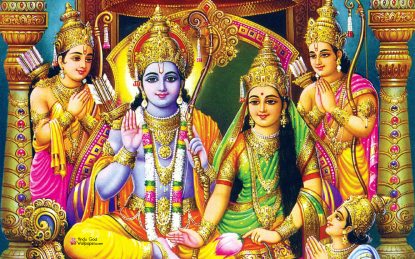
In the previous episode we had seen that King Dasharata was blessed with four sons and the naming ceremony for the newborns were held in grand fashion at Ayodhya. The babies were named “Rama”, “Lakshmana”, “Bharata” and “Shathrughna” by Sage Vasishtacharya, the “Kula Guru” of the entire Ikshvaaku Dynasty. Hence, with the request of the Devas (the celestial beings) and Lord Brahma, we finally see here that the Lord has incarnated. Many of us might know this famous sloka from the “Bhagawad Gita” where Lord Krishna himself says:
“Parithraanaaya saadhuunaam vinaashaayacha dushkruthaam!
Dharma samsthaabhanaarthaaya sambhavaami yuge yuge!!”
Here, Lord Krishna says that in each “Yuga” (Can be somewhat equated to “Age”), he would incarnate on this world for the following purposes: To protect the “Saadhus” (Good people), to destroy the evil (Bad elements). Bhagawan from his abode of Vaikunta itself can easily perform these above-mentioned two purposes. However there is a third important function of Bhagawan’s incarnation – To establish/re-establish the “Dharma” (Righteousness) in the world. It is for this main purpose that Bhagawan incarnates in this world every time! In that way, with respect to Lord Vishnu we see ten major “Avataars” (Incarnations) that He has taken in this world. Of course, there are many more, but for our understanding, our great sages have widely spoken about the main ten. Here is a beautiful “paasuram” of Thirumangai Aalwaar in Tamil, explaining the significance of the Rama-Avatar.
“Meenoodu aamai kezhal ari kuralaai!
Munnumi raamanaai thaanaai pinnumi raamanaai thaamotharanaai kalkiyum aanaar!!”
Here, Thirumangai Aalwaar brings our all the ten avataars of Lord Vishnu from just one paasuram. He says, “Meenoodu” (Matsya Avataar – in the form of a fish) “Aamai” (Koorma Avataar – in the form of a tortoise) “Kezhal” (Varaaha Avataar in the form of a boar) “Ari” (Narasimha Avataar – in the form of a “Half-lion, Half-Human) “Kuralaai” (Vaamana Avatar – in the form of a short brahmin boy)”. In the second line he uses a very interesting analogy to describe the rest of the incarnations: “Munnumi raaman” means, “Parasuraama”, which is the incarnation before the “Raama-Avataar”, “Pinnumi raaman” means, “Balaraama”, which is the incarnation after the “Raama-Avataar”. Of course all of us would be familiar with the last two incarnations – “Thaamotharan” means Lord Krishna and the final “Kalki” avatar is yet to take place in this Kali Yuga.
It is very interesting to note in the above “paasuram” that, for every “avatar” he had mentioned the corresponding names of all of them, but when he mentions the “Rama-Avatar” he uses a word called “Thaanaai”. One might pose a question here: Is “Thaanaai” a right word here? If a Tamil poetry should be correct, it should have been “Munnumi raamanaai Naduvinil raamanaai Pinnumi raamanaai…” But in the actual paasuram it is mentioned as Munnumi raamanaai Thaanaai pinnumi raamanaai…” Why has he used the word “Thaanaai” here? Here’s a beautiful explanation for it. In Tamil, the word “Thaanaai” means “Self” or “Volunteering”, etc. Thus with this meaning, we can infer that, Bhagawan Vishnu “voluntarily” and “lovingly” incarnated as Lord Rama in this world. In other words, whatever paths of Dharma he wanted to show and preach to this world, He did everything clearly and set himself as the role model for all of us to follow! This is the reason why the “Rama-Avatar” is extremely significant!
It was during the “Tretha Yuga” that Lord Rama incarnated. Till now, we have seen His birth as the darling son to Kaushalya Devi and king Dasharata. This is why Lord Rama is fondly called as “Dasharataatmaja”. Now when we move forward, it is quite interesting to note from the Valmiki Ramayana text that Valmiki Maharishi has directly and very quickly moved twelve years of Lord Rama’s life in a jiffy! In the eighteenth “Sarga” (Chapter) of the “Baala-Kaanda” he talks about Lord Rama’s birth and in the same chapter towards the end he says that Sage Vishwaamithra enters Ayodhya. If Sage Vishwaamithra has entered into the context it means that the auspicious wedding between Lord Rama and Sita Devi is not very far off! According to the Baala-Kaanda, Lord Rama’s wedding has taken place on the fifteenth day after Sage Vishwaamithra takes Rama along with him. It is only in the meanwhile, within around eighteen slokas, Valmiki Maahrishi says that Rama and his brothers were sent by King Dasharata to the ashram of Sage Vasishtaachaarya and all the four brothers did their “Gurukula-Vaasa” wherein, they were inculcated with all the required education – They were trained for artillery, bow and arrow and different kinds of fighting as a “Kshathrya” prince and also on the scriptures like Vedas and Upanishads. Thus, at the age of twelve, Rama and his brothers became proficient with all the required skills and competencies to rule the kingdom of Ayodhya after their father.
It is at this stage when Sage Vishwaamithra comes to Ayodhya seeking King Dasharatha’s help. What help did Sage Vishwaamithra want? What happened after that? Here is where we pick up the story from now! Let’s also wait till the next episode to commence!

Dear Sir,
Nice blog you are creating and maintaining. I am a regular reader of this episodes.
Just one observation on this episode. You mentioned next Rama as “Pinnubi” in all the places. It should be correctly spelled as “Pinnumi”. Here is the actual reference.
திருமங்கை ஆழ்வார் அருளிச்செய்த பெரியதிருமொழியில் எட்டாம்பத்து எட்டாந்திருமொழி (வானோரளவும்) கடைசி பாட்டில்
மீனோடாமைகேழலரிகுறளாய் முன்னுமிராமனாய்த்
தானாய் * பின்னுமிராமனாய்த்தாமோதரனாய்க் கற்கியு
மானான்றன்னை * கண்ணபுரத்தடியன் கலியனொலிசெய்த *
தேனாரின்சொல்தமிழ்மாலை செப்பப்பாவம்நில்லாவே. || 8.8.10
adiyen
Srinivasan
LikeLike
Thank you so much! Yes. It is an error from my side and I would correct it! Thanks for the encouragement!
LikeLike